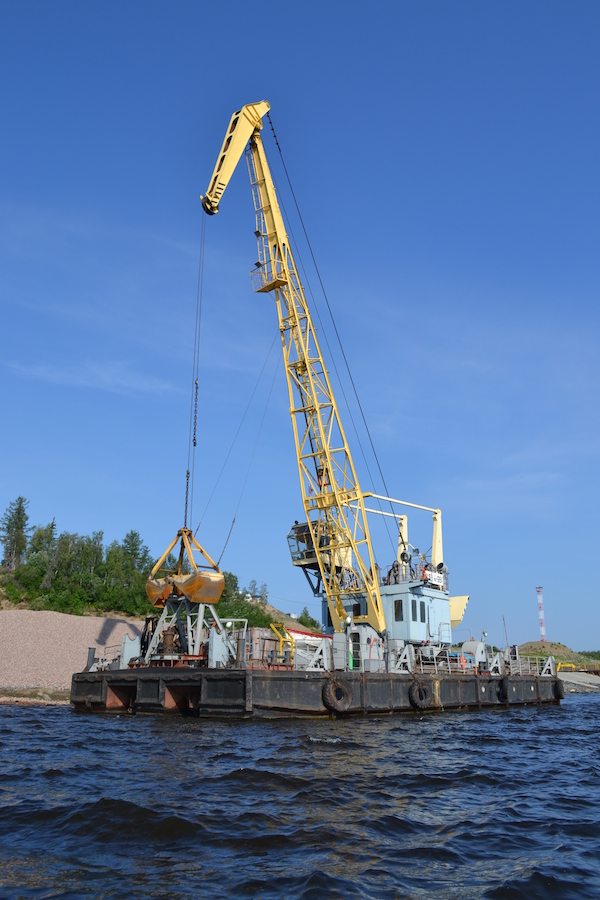Course for UDT certification as a maintainer and operator of floating cranes
What is a floating crane?
A floating crane is a specialised vessel with a crane mounted on a floating steel pontoon. The equipment is used, among other things, for work on the open sea, in shipyards or ports, as well as in places where the work of port or shipyard cranes is difficult or completely impossible. Floating cranes may be self-propelled (which is much more common) or not. In the case of cranes that do not have propulsion, pushers or tugboats are needed to move them.
Division of floating cranes
We can divide floating cranes into two basic types:
- crane with swivel arm - In this case, the lifting device can usually rotate 360 degrees and is mounted on a shaft. Once the arm has rotated, the cranes are able to lay and transport the load to the cargo deck, which they are usually equipped with. Cranes with a swivel arm are more expensive and complex in terms of their construction, while at the same time they are more convenient and versatile in operation. An example of this type of floating crane is the second largest crane 'Maja'.
- fixed arm crane (the so-called scissor lift "sheerleg" or "A-frame") - This type of crane is characterised by the fact that its arm, which is responsible for lifting the load, usually resembles a capital 'A' in shape. Its lower ends are mounted directly to the pontoon through special axes that allow the hook to be raised and lowered and the arm to move only forwards and backwards. Thus, in order to lift a load, the above crane has to moor with the stern or bow in front of the load to be lifted, and the transport of the load sideways is done in this case by the movement of the whole pontoon. This type of crane is simpler and less expensive to construct compared to slewing arm cranes, because by virtue of the lack of lateral stability problems when lifting loads from the side, they can usually lift relatively larger loads. A representative of this type of crane is, among others, the 'Conrad CONSUL'.
Largest floating cranes in Poland
The largest floating cranes in Poland are Maya, Conrad CONSUL and REM-220.
For whom is the training intended?
Our course is designed for anyone wishing to broaden their existing qualifications in the operation and maintenance of floating cranes or to learn about them from scratch. Our training is primarily aimed at those wishing to sit for the UDT (German Technical Inspection Authority) exam in order to gain qualifications as a maintainer or operator of the above-mentioned machines.
Conditions of participation in the training course for maintenance and railway crane operators:
- paying for the course;
- reaching the age of 18 - coming of age;
- have a minimum of primary education;
- certificate of no health contraindication.
What does the course look like?
Our training is divided into two parts - theoretical as well as practical. During the theoretical classes, participants will mainly learn the theoretical knowledge necessary for the work of a floating crane operator and maintainer. The practical classes, on the other hand, will enable trainees to skilfully translate the knowledge gained during lectures into improved skills in the use of the machine.
Railway crane course programme
The scope of the training includes, but is not limited to, topics such as:
- General information on cranes and their components, construction and types of cranes and cranes, technical performance;
- legislation, documentation and information on technical supervision;
- Operation and maintenance and repair and inspection of floating cranes;
- the duties of the maintainer and operator of floating cranes before, during and after working with the equipment on the site;
- slings and handling aids;
- health and safety rules for the use of floating cranes, as well as fire and environmental issues;
- operating rules and maintenance plan for the equipment;
- principles for cleaning equipment;
- required standards and conditions for working with cranes;
- practical exercises.
Period of validity of allowances
The qualifications, which are issued by the UDT, TDT or WDT for operator or maintainer of floating cranes, are issued for a period of 5 years. However, in the event that, at least 3 months before the end of the validity of the qualifications obtained, the holder submits an appropriate application confirming his/her work as a crane operator or maintainer, it is possible to extend them
Our other courses
In addition to a course on floating cranes, by working with us you can gain a UDT qualifications on machines such as:
- HDS mobile and mobile cranes;
- tower cranes;
- stationary cranes;
- high speed cranes;
- mobile cranes;
- rail-mounted cranes;
- deck cranes;
- railway cranes and on railway ramps.
We look forward to hearing from you!
Questions and Answers
What types of floating cranes is the course organised for?
In our classes, we will focus on the topics of floating cranes with a fixed arm and floating cranes with a swivel arm.
What is the validity period for floating crane ratings?
Authorisations for floating cranes are issued for a period of five years, but there is the possibility of extending them through a special application to the UDT submitted three months before the expiry date of the document held.
More information:
- Maintenance and rail crane operator qualification course
- UDT certification for operators and maintainers of tower and high-speed cranes
- Course for UDT certification as a maintainer and operator of floating cranes
- Course for tower and high-speed cranes
- Training for mobile crane operators
- UDT certification for deck crane operators and maintainers



































